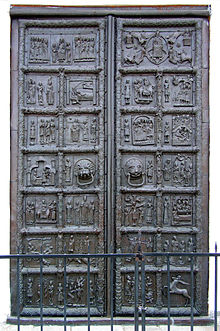Bronze door from plock

The bronze door from Płock was originally intended for the Płock Cathedral , but it is located in the west portal of the St. Sophia Cathedral in the Novgorod Kremlin .
It was built in 1152–1154 in Magdeburg on the order of the Bishop of Płock, Alexander from Malonne , and was originally built into the cathedral, which was built in 1130–1144. The order was entrusted to Master Riquinus and (presumably) his helper Waismuth through the mediation of Magdeburg Bishop Wichmann .
The components of the door were cast separately and nailed to the wooden door leaves in a partially confused order.
There are wide borders between the panels with figurative motifs . In total, the door consists of 24 square and 2 rectangular bronze panels of double width (above). Between the panels were strips with plant ornaments, in the upper part replaced by figural motifs of knights and beasts.
The plates represent the cycle of redemption, beginning with the scene of the creation of the first man to Christ as the judge of the world, enthroned surrounded by evangelist symbols. Many plates are dedicated to the childhood of Jesus and the passion story. The figure of the prophet Elias on the chariot acts as a typological parallel to the ascension of Christ.
The plate with the two figures of heavily armored knights and two defeated opponents lying down is titled by an inscription as “poverty”.
The door pullers are designed in the form of lions' heads that hold small human heads in half-open mouths. Bishop Alexander was depicted in liturgical garb between two deacons, Bishop Wichmann and the authors of the door.
The art historian Zygmunt Świechowski found a similarity between this door and the doors of San Zeno in Verona and the door of the Augsburg Cathedral.
The history of the bronze door
According to previous research, the door stayed in Płock for 250 years, after which it was brought to Novgorod and installed in the St. Sophia Cathedral in the Novgorod Kremlin . Either it was stolen by the Lithuanians during a raid through Mazovia in the 13th century , or it was given to the prince of Novgorod, Simon Lingwen, the brother of Władysław II Jagiełło , by the clergy or by the prince of Płock.
An epoxy resin cast was made in 1962 , and a bronze copy was cast in 1978–1981, which adorns Płock Cathedral to this day.
source
- Świechowski Zygmunt: Sztuka romańska w Polsce . Arkady, Warszawa 1982, ISBN 83-213-2925-X , pp. 67-69 .
- Willibald Sauerländer : The bronze door of Novgorod . R. Piper & Co Verlag, Munich 1963
See also
Coordinates: 58 ° 31 ′ 18 ″ N , 31 ° 16 ′ 34 ″ E


